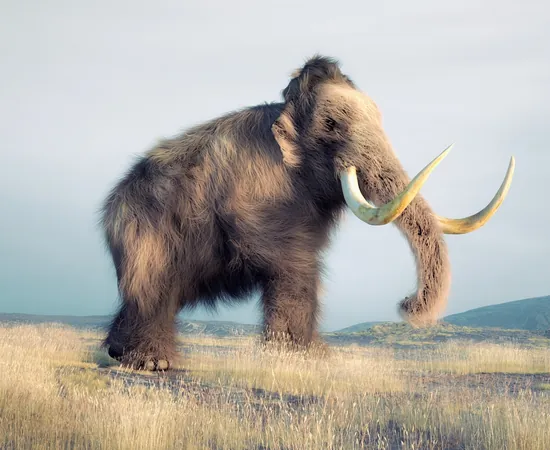
Ancient Mammoth Microbes Uncover Secrets to Disease and Extinction
2025-09-05
Author: John Tan
Discovering Ancient Microbial DNA in Mammoths
A groundbreaking study has unearthed microbial DNA from woolly and steppe mammoth remains dating back over a million years. This remarkable research reveals that certain bacteria existed alongside these majestic creatures during their lifetimes, suggesting a synergy that persisted through the ages.
Revolutionary Findings from the Ice Age
Led by Benjamin Guinet at the Centre for Palaeogenetics in Stockholm, the research team meticulously analyzed 483 specimens, successfully sequencing 440 for the first time. Among their astounding discoveries was the reconstruction of partial bacterial genomes from a steppe mammoth that lived about 1.1 million years ago.
Guinet remarked, "Our results push the exploration of microbial DNA beyond a million years, opening new avenues to investigate how these microbes evolved with their hosts." This study marks a significant stride in understanding ancient microbial communities.
The Journey of Microbial Life in Mammoths
By employing rigorous protocols, the researchers distinguished microbial DNA from postmortem contaminants, focusing solely on those present while the mammoths were alive. They consistently identified six types of bacteria, including relatives of Actinobacillus and Streptococcus, across different specimens, indicating a long-standing relationship with these megafauna.
Unraveling the Mysteries of Ancient Microbes
Utilizing advanced metagenomics, the team authenticated the oldest known host-associated microbial DNA ever found. This discovery extends the potential for studying interactions between ancient hosts and their microbial counterparts.
Why Do Ancient Microbes Matter?
The implications of this research are vast, as it not only sheds light on the microbial life that coexisted with mammoths but also provides insights into how microbes influenced qualities like adaptation, disease progression, and extinction rates during the Pleistocene epoch.
Links to Modern Wildlife Health
Interestingly, one bacterium identified in the mammoth dataset closely resembles a species known to cause fatal diseases in modern African elephants. This connection is backed by recent studies linking cut to lethal outbreaks in wildlife, suggesting the persistence of certain pathogens through time.
A New Understanding of Mammoth Survival
The findings illuminate stable microbial relationships shaped by various factors, including diet and climate, hinting at a profound co-evolution between mammoths and their microbial companions. Evidence suggests that these relationships may have played a crucial role in mammoths' health and survival.
The Future of Ancient Microbiome Research
Looking forward, understanding ancient microbiomes could help establish baselines for modern elephant health and inform conservation strategies. Additionally, the tools developed in this study can be applied to other Ice Age species, enhancing our understanding of the microbial dynamics that shaped our planet's ecological history.
Publishing New Discoveries
This pivotal research has been published in the prestigious journal Cell, marking a significant contribution to the fields of paleogenetics and microbiology. As scientists delve deeper into these ancient ecosystems, the lessons learned could reshape our perspectives on health, disease, and the survival of species in a changing world.



 Brasil (PT)
Brasil (PT)
 Canada (EN)
Canada (EN)
 Chile (ES)
Chile (ES)
 Česko (CS)
Česko (CS)
 대한민국 (KO)
대한민국 (KO)
 España (ES)
España (ES)
 France (FR)
France (FR)
 Hong Kong (EN)
Hong Kong (EN)
 Italia (IT)
Italia (IT)
 日本 (JA)
日本 (JA)
 Magyarország (HU)
Magyarország (HU)
 Norge (NO)
Norge (NO)
 Polska (PL)
Polska (PL)
 Schweiz (DE)
Schweiz (DE)
 Singapore (EN)
Singapore (EN)
 Sverige (SV)
Sverige (SV)
 Suomi (FI)
Suomi (FI)
 Türkiye (TR)
Türkiye (TR)
 الإمارات العربية المتحدة (AR)
الإمارات العربية المتحدة (AR)